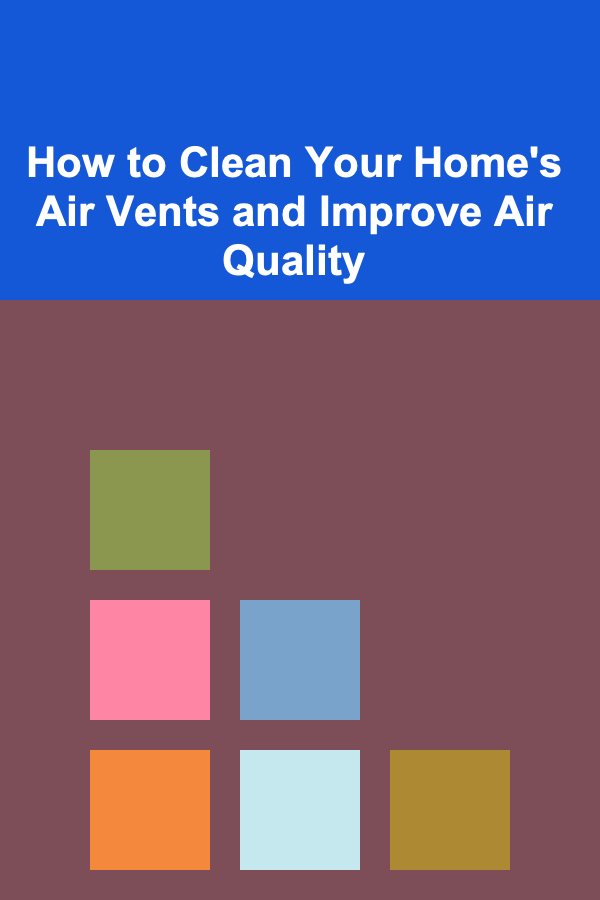
How to Clean Your Home's Air Vents and Improve Air Quality
ebook include PDF & Audio bundle (Micro Guide)
$12.99$5.99
Limited Time Offer! Order within the next:

Air quality inside your home is one of the most important aspects of creating a healthy living environment. Poor indoor air quality can lead to various health problems, including respiratory issues, allergies, and even headaches. One area that often gets overlooked when it comes to maintaining air quality is the air vents in your home. Air vents are essential for circulating air throughout your home, but over time, they can become clogged with dust, debris, and other pollutants. Cleaning your air vents not only helps to improve the air quality in your home but can also enhance the efficiency of your HVAC (Heating, Ventilation, and Air Conditioning) system.
In this comprehensive guide, we will discuss the importance of clean air vents, the steps involved in cleaning them, and other practical tips to improve indoor air quality. Whether you have central air conditioning, heating, or a standalone HVAC system, understanding how to maintain and clean your air vents is crucial for a healthier, more comfortable home.
Why Cleaning Air Vents is Essential
Air vents are the gateway for air to flow through your home's HVAC system. While they are designed to circulate air efficiently, they can also become breeding grounds for dust, dirt, mold, pet dander, and other allergens. If left uncleaned, these contaminants can recirculate through your home, worsening indoor air quality and potentially triggering health problems.
Here are some key reasons why cleaning your air vents is essential:
1. Improves Air Quality
When dust, dirt, or pet dander builds up inside your vents, these pollutants can be distributed throughout your home each time the HVAC system is used. Cleaning the air vents ensures that the air circulating through your home is cleaner and healthier.
2. Prevents Mold Growth
In areas with high humidity, mold can grow inside the vents and ducts. This is particularly common in bathrooms, kitchens, and basements. Mold spores can trigger allergies and respiratory issues, especially in people with asthma or compromised immune systems. Regular cleaning helps prevent mold growth and its associated health risks.
3. Boosts HVAC Efficiency
Clogged vents can strain your HVAC system, making it work harder to circulate air. This can lead to higher energy bills and a reduced lifespan for your system. By cleaning your air vents, you help the system function more efficiently, ultimately saving money on utility bills and prolonging the life of your HVAC system.
4. Reduces Allergens
Air vents act as collection points for airborne allergens such as dust, pollen, and pet dander. Over time, these particles can accumulate and be redistributed into the air, causing allergies to flare up. Regular cleaning of the vents helps to minimize the buildup of allergens, improving air quality for those with sensitivities.
5. Improves Odor Control
Foul odors, including those from cooking, pets, or even musty air, can accumulate in the ducts and vents. These odors are then recirculated through your home when the HVAC system is running. Cleaning the air vents helps to eliminate trapped odors and refreshes the air inside your home.
Tools You Will Need to Clean Your Air Vents
Before you begin cleaning your air vents, you'll need to gather a few essential tools to ensure a thorough and efficient cleaning process. Here's a list of tools and supplies you may need:
- Vacuum Cleaner: A vacuum with a hose attachment or a special brush attachment for reaching inside the vents is necessary for removing dust and debris.
- Soft Brush: A soft-bristled brush or a vent cleaning brush is helpful for scrubbing off stuck-on dirt or grime from the vents.
- Microfiber Cloths: These are ideal for wiping down surfaces and removing dust without leaving behind fibers or streaks.
- Cleaning Solution: A mild cleaning solution or a mixture of water and vinegar works well for disinfecting and sanitizing the vents.
- Compressed Air: If you can't access some parts of the vents with a brush or cloth, using compressed air can help blow away dust and debris.
- Ladder or Step Stool: If your air vents are located on the ceiling or in hard-to-reach places, you may need a ladder to safely access them.
- Rubber Gloves: Wearing gloves can protect your hands from dirt, dust, and chemicals during the cleaning process.
- Flashlight: A flashlight will help you inspect hard-to-see areas inside your air ducts and vents.
Steps for Cleaning Your Air Vents
Now that you understand the importance of cleaning your air vents and have gathered the necessary tools, it's time to start the cleaning process. Follow these detailed steps to ensure that your air vents are thoroughly cleaned and your air quality is improved.
1. Turn Off the HVAC System
Before cleaning your air vents, it's important to turn off your HVAC system. This ensures your safety and prevents dust or debris from being blown around during the cleaning process. It also allows you to thoroughly clean the vents without any interference from air circulation.
2. Remove the Vent Covers
Once the system is turned off, use a screwdriver or simply pull off the vent covers to expose the inside of the vents. Some vent covers may be secured with screws, while others are designed to be easily removed by hand. Be careful not to damage the covers while removing them.
3. Vacuum the Vents
Using a vacuum cleaner with a hose attachment, carefully vacuum the inside of the vent to remove loose dust, dirt, and debris. Start at the back of the vent and work your way forward to avoid pushing debris further into the ducts. If you have a brush attachment, use it to scrub the walls of the vent to dislodge stuck dirt.
4. Use Compressed Air (If Needed)
For vents that are difficult to reach with a vacuum, consider using a can of compressed air. Direct the air into the vent to blow away dust and debris. Be sure to wear a dust mask during this step to avoid inhaling any particles.
5. Clean the Vent Covers
While the inside of the vent is being cleaned, don't forget to clean the vent covers themselves. Wipe them down with a damp microfiber cloth and use a soft brush to remove any stubborn dirt. If necessary, you can soak the vent covers in warm water with mild soap for a deeper clean.
6. Sanitize the Vents (Optional)
If you are concerned about germs or bacteria in the vents, consider using a disinfectant solution to sanitize the area. Mix a solution of water and vinegar or use a commercial HVAC cleaner. Lightly spray the interior of the vents and wipe down the surfaces with a microfiber cloth.
7. Check for Mold and Mildew
Inspect the interior of your vents for any signs of mold or mildew, especially in humid areas of your home such as bathrooms or basements. If you notice any growth, use a mixture of water and vinegar or a specialized mold cleaner to treat the affected areas. Mold removal may require more advanced techniques or professional help if the issue is severe.
8. Replace or Clean Air Filters
While you're cleaning the air vents, it's a good idea to check the air filters in your HVAC system. Dirty or clogged filters can significantly reduce air quality and system efficiency. If the filters are dirty, replace them with new ones. If your system uses reusable filters, clean them thoroughly according to the manufacturer's instructions.
9. Reassemble the Vent Covers
After cleaning the vents and covers, carefully replace the vent covers back in their original positions. Be sure they are securely attached to prevent air leaks. If your vents are secured with screws, use a screwdriver to fasten the covers back in place.
10. Turn the HVAC System Back On
Once everything is cleaned and reassembled, turn your HVAC system back on. Run the system for a few minutes to ensure that air is flowing properly through the vents and that everything is working as it should.
Additional Tips for Maintaining Clean Air Vents
Cleaning your air vents once a year is an excellent start, but there are other steps you can take to maintain the cleanliness of your vents and improve your indoor air quality on an ongoing basis. Here are some additional tips to consider:
1. Change Air Filters Regularly
Replace or clean your HVAC system's air filters at least every 3 months, or more often if you have pets or live in a dusty area. Clean filters help maintain good air quality and ensure that your system operates efficiently.
2. Use an Air Purifier
An air purifier can help remove airborne particles such as dust, pollen, and pet dander, preventing them from accumulating in your vents. Consider using a HEPA (High-Efficiency Particulate Air) filter, which is highly effective at trapping small particles.
3. Control Humidity Levels
Excess humidity can promote mold and mildew growth in your air vents. Use a dehumidifier to maintain a comfortable humidity level in your home, especially in areas prone to moisture, such as bathrooms and basements.
4. Seal Duct Leaks
Leaky ducts can lead to inefficient air distribution and lower indoor air quality. Inspect your ducts for any visible leaks and seal them using appropriate materials, such as duct tape or mastic sealant.
5. Keep Your Home Clean
Regularly dusting and vacuuming your home helps reduce the amount of dirt and debris that can make its way into your air vents. Pay attention to areas near vents, as these tend to accumulate dust and dirt quickly.
6. Schedule Professional Duct Cleaning
While cleaning your air vents yourself can significantly improve air quality, professional duct cleaning may be necessary for more thorough cleaning, especially if you haven't had your ducts cleaned in several years. A professional can remove deep-seated dirt, dust, mold, and allergens from your system, ensuring a more thorough job.
Conclusion
Cleaning your air vents is an essential task that should not be overlooked if you want to maintain good indoor air quality and optimize the efficiency of your HVAC system. By following the steps outlined in this guide, you can clean your air vents effectively, reduce allergens and pollutants, and improve the overall air quality in your home. Additionally, adopting good habits like changing air filters regularly, controlling humidity levels, and scheduling professional cleaning will ensure that your home remains a healthy and comfortable environment for you and your family.

How to Incorporate Color Temperature in Your Lighting Choices
Read More
How to Keep Your Refrigerator Organized with Clever Storage Solutions
Read More
How to Utilize Online Libraries and Resources Effectively
Read More
The Art of Storytelling with Customer Insights: Crafting Engaging Reports and Presentations
Read More
How to Research Blockchain Security Fundamentals
Read More
How To Explore EV Battery Swapping Technology
Read MoreOther Products

How to Incorporate Color Temperature in Your Lighting Choices
Read More
How to Keep Your Refrigerator Organized with Clever Storage Solutions
Read More
How to Utilize Online Libraries and Resources Effectively
Read More
The Art of Storytelling with Customer Insights: Crafting Engaging Reports and Presentations
Read More
How to Research Blockchain Security Fundamentals
Read More